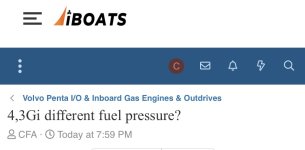How do I identify my Volvo Penta gas engine and what does the model name tell me about the engine?
A metal tag is riveted to all Volvo Penta engines. Some of our products also have the information on a decal on the top of the product. Locate any of these on your engine and you will know the model. In the case above the name is 5.7Gi-B.
What does the model name tell me about my engine?
Several methods have been used to provide the engines with unique names. Some were based on horsepower ratings. More recent names are based on the displacement of the engine in liters.
Each time the name was changed, it was due to some change in the parts content of the engine. Sometimes the changes were minor, sometimes they were major. The changes may or may not affect the parts that you need for example a repair.
There are three distinct periods of gas engine production, each with a different naming method.
Red Engines, early
Very early engines, built until the late 1980.s, were named based on the displacement (early) or horsepower (later) of the engines. The name started with AQ (sterndrive engine), BB (inboard) or MB (inboard). Next came the number for the displacement or horsepower. Most of these also included a one letter suffix, for version control. An AQ271A is older (and different) than a AQ271B.
Examples: AQ260A, AQ171C, AQ200F, BB260A
These engine names then changed to a system based on displacement. The names were a three digit number, followed by a letter. The first two digits of the number represented the displacement. The 43 in 434A meant the engine was a 4.3L. The third digit was used for version control. A 430 and a 431 are both 4.3L.s, however the last digit indicates there is difference between the engines. The numbers at the third digit were not always sequential. 430.s were built before 431.s, however 432.s and 434.s were built at the same time.
The letter at the end was also used for version control and was sequential. A 500A was built before a 500B. These engines went out of production in 1993.
Examples: 432A, 500B, 251A, 740B
Nothing in the names in either of these systems relates in any way to years of production. Some of these engines were in production for less than a year, others for many years.
Charcoal engines
These engines were built during the joint venture with OMC and were painted a dark charcoal color. They were usually named by long character strings that contain two numbers followed by a series of letters.
- The two numbers are the displacement.
- Next is the letter that indicates who made the base engine. ( G=GM, F=Ford)
- After that, one or two letters that note the fuel system and/or output. L=Limited, S=Superior, X=Exceptional, i or I=Fuel injected (no I means carburated).
- Then one letter for the steering system. P=Power steering, M=Manual steering, X=Exact steering, I=Inboard
- The next two letters are the most important for finding parts. These are random letter pairs that indicate the years of production for the engine. All parts information for these engines is based on these letter codes, including the charts that follow later in the book.
MD = 1993-1994 BY = 1997-1998
HU = 1994-1995 WT = 1998-1999
NC = 1995-1996 EF = 1999-2000
LK = 1996-1997
The next letter is also random and is used for version control. An .A. may not be the first version. .A.C. may not have been built before an .S.. An .S. in one engine's name may not mean the same thing as an .S. in another engine's name, especially if the engines have different displacements or production years. When needed this code is noted in the charts. There are instances where it is needed to find the right column for an engine.
Some names have the letters .CE. at the end. This indicates the engine meets certain emission requirements. The only service part affected is the ECU. These part numbers are noted when needed in the catalogs.
These engines went out of production in 2000.
Examples:
4.3GLPBYC = 4.3L, G=GM, L=limited output, carbureted (no i), P=power steering, BY=built 1997-1998, C=service code for version control.
5.8FSiPNCACE = 5.8L, Ford, Superior output, injected, power steering, NC=built 1995-1996, A service code, certified emissions.
7.4GLPHUS = 7.4L, GM, limited output, carbureted, power steering, HU=built 1994-1995, S service code.
3.0GLMMDA = 3.0L, GM, LIMITED output, carbureted, manual steering, MD=built 1993 1994, A service code.
Red Engines, current
Beginning in 2000 the gas engines are painted red again. The naming system was also changed. The first part of the name is the same as the charcoal engines, up to the letters for the fuel system.
- The two numbers are the displacement.
- Next is a letter that indicates who made the base engine. New engines have been added that use Volvo Penta's new Ocean Series sterndrives, these engines have an OS for this letter.
- After that, one or two letters that note the fuel system and/or output.
- For 3.0L only, there is an M or P for the steering
- For Inboard engines only, there is an I after the lower case i.
- Then a dash (-) followed by a one or two letter suffix. This is the major change from the charcoal engines above.
- The first letter is the version control, this is present on all current engines. .A is the first version, -B is the second version, etc. There is no link between the suffix and production years. All engines with .A were not built the same year. A 5.7GXi-B and a 5.0GXi-B are not similar. A 4.3GL-D is newer than and different from a 4.3GL-C.
- The second letter, if present is always an F, it notes that the engine is freshwater cooled.
Examples: 3.0GLM-C, 4.3GXi-DF, 5.0OSi-E, 8.1GXiI-B






















